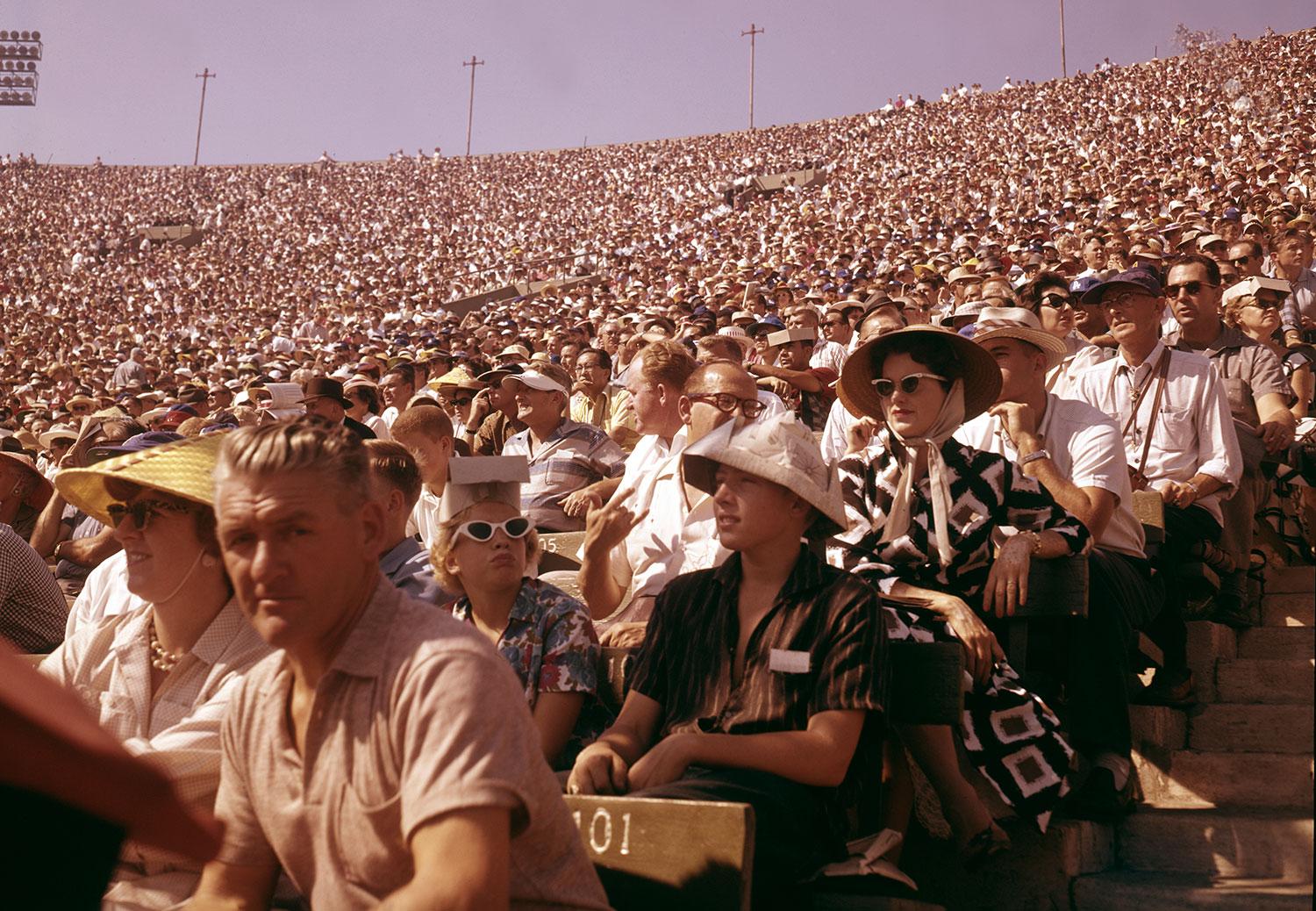
Long Ball

View of fans at the Los Angeles Memorial Coliseum during a Dodgers baseball game, Los Angeles, Calif., 1957.
CU-Boulder historian Tom Zeiler introduced students to "America through baseball" nearly 15 years ago. They clamored to get in then, and still do.
Babe Ruth
The Yankees’ Babe Ruth personifies the Roaring ’20s, also known as the Jazz Age, says history instructor Martin Babicz — “big, loud and rambunctious.”
Jackie Robinson
Jackie Robinson’s 1947 debut with the Brooklyn Dodgers as Major League Baseball’s first black player prompts examination of racial attitudes in the U.S.
Cincinnati Reds
The Cincinnati Reds’ decision to change their name, briefly, to the Redlegs illustrates the depth of anti-communist hysteria in the United States in the 1950s.
Brooklyn Dodgers
The relocation to California of the Brooklyn Dodgers and New York Giants after World War II helps bring to life western migration and the rise of the sun belt.
To Zach Weinstein, Tom Zeiler’s arrival in his Jewish Studies seminar one day last winter seemed a favorable sign, especially after Zeiler sat next to him.
Weinstein (Hist, Phil’16) had always wanted to take “America through Baseball,” the hugely popular course that Zeiler, a CU-Boulder history professor, pioneered on campus. But the timing had never worked out.
It suddenly seemed it might: Zeiler, who was observing the seminar, revealed he would offer the baseball course as an on-campus lecture for the first time in years and in its biggest incarnation yet, 250 students.
“I’m lucky that I’m still here,” says Weinstein, 25, who started at CU in 2007, left to work, then came back.
Zeiler developed “America through Baseball” in 2000, while researching a book about baseball and cultural diplomacy. He thought the course might broaden undergraduate appetites for meaty topics in American history — urbanization, nationalism, labor strife, the Roaring ’20s, race relations, the Cold War and globalization.
It proved a hit.
“People from all different majors want to take it,” says Weinstein.
Over time, Zeiler has offered the course as a lecture, a seminar and, most often lately, a full-credit online course. When he taught it in baseball-crazed Japan during a Fulbright fellowship, the president of Japan Women’s University dropped in, he says. So did Bobby Valentine, the former New York Mets manager, then working in Japan.
Eventually, CU history instructor Martin Babicz (PhDHist’09) also began offering the course, as a freshman seminar.
Whatever the format, “America through Baseball” is not about box scores.
“This is American society and history,” Zeiler, an expert in U.S. diplomatic history and director of the Program on International Affairs, tells students. “You don’t come in here because you have a baseball mitt.”
For the professors, baseball offers both a framework and a bounty of personalities for dramatizing and personalizing American history.
The careers of 19th-century player-businessmen Albert Spalding and John Montgomery Ward lead to discussion of baseball’s growth as a complex capitalist enterprise and the rise of labor unions, for example. Babe Ruth, larger than life, personifies the Roaring ’20s. And Jackie Robinson’s 1947 debut with the Brooklyn Dodgers as Major League Baseball’s first black player prompts examination of racial attitudes.
In the same way, the Cincinnati Reds’ decision to change their name, briefly, to the Redlegs illustrates the depth of anti-communist hysteria in the 1950s. And the relocation to California of the Brooklyn Dodgers and New York Giants after World War II helps bring to life western migration and the rise of the sun belt.
When Zeiler first proposed the course, some colleagues questioned its academic merit, he says. But like baseball-minded professors before and after him, he prevailed. San Francisco State, Kansas State, the University of Iowa, the University of Chicago, Tufts and Harvard, among others, all offer or have offered baseball-related courses.
Interest in baseball as a vehicle for teaching American history is now so widespread that publisher Rowman & Littlefield has hired Zeiler and Babicz to write a textbook tentatively titled National Pastime: United States History through Baseball.
CU students of all kinds take the course — baseball aficionados and novices, accounting majors and engineers, the simply curious and the intensely motivated. Zeiler says at least half the students are women. Babicz finds that many students perform better than their counterparts in his conventional American history survey.
For Weinstein, the main appeal is the unusual approach to the material and a sense of its potential, he says, to “confront me with something I don’t normally think about.”
The course works its influence beyond the classroom, too. Lisa Mercadante (IntlAf’09) couldn’t fit it into her schedule — but its existence alerted her to Zeiler, who advised her honors thesis about MLB’s effect on the Dominican Republic, a key source of players today.
Now a graduate student and teacher of English as a second language, Mercadante is exploring roles with professional baseball teams as a mentor for foreign players.
“America through Baseball,” like sport itself, brings people together. Jesse Lopez (Acct’15) took the course online, visiting his father nightly to share the experience. The former Marine, 30, says it deepened his understanding of racism in America.
“It was incredible to read things and then have my father explain what he was going through at that time or his understanding of it,” says Lopez.
In the fall, Zeiler anticipates another full house for “America through Baseball.”
“Everyone in the class is eligible for an A,” he jokes. “It just doesn’t work out that way.”
Photography by Camerique/Getty Images (fans at Dodgers baseball game); Ralph Morse/The LIFE Picture Collection/Getty Images (Babe Ruth at Yankee Stadium); © Bettmann/CORBIS

